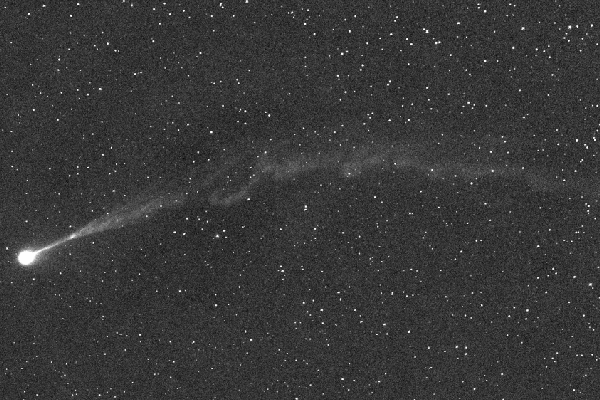An intriguing new celestial object known as Comet Nishimura is enduring a bumpy ride through the inner solar system despite having its tail torn off by an outburst from the sun.
Japanese amateur astronomer Hideo Nishimura discovered the comet, officially dubbed C/2023 P1, in August, about a month before its closest approach to Earth, which astronomers project will occur on September 12. As the comet continued its sunward voyage and absorbed more energy from our star, its trailing tail of escaping gas and dust correspondingly grew. But Comet Nishimura’s short journey since its discovery hasn’t been smooth: on September 2, a solar storm sent gobs of charged particles called a coronal mass ejection (CME) barreling through the comet’s tail, briefly blowing it to smithereens.
“Sometimes the sun just blows out some very energetic stuff, and that tears a portion of the comet’s tail away and gives people an impression that the comet tail disconnects,” says Quanzhi Ye, a planetary astronomer at the University of Maryland and Boston University, of the phenomenon. “But the comet is totally fine. When it enters a calmer environment, you will see the tail regrow.”
On supporting science journalism
If you're enjoying this article, consider supporting our award-winning journalism by subscribing. By purchasing a subscription you are helping to ensure the future of impactful stories about the discoveries and ideas shaping our world today.
Comet Nishimura’s environment might not stay calm long, though, according to SpaceWeather.com. Two more CMEs are now heading toward the comet, although it’s not yet clear whether they’ll intersect with the dirty snowball and further disrupt its tail.
Comet Nishimura is a lucky sight regardless of its unlucky tail, Ye says. The comet is relatively bright as it heads toward its closest pass by the sun on September 17, when it will be 27 million miles from the star, closer than the solar system’s innermost planet, Mercury. The last time Earthlings enjoyed a bright comet near the sun was in the summer of 2020, when a similar celestial spectacle from Comet NEOWISE provided a brief distraction from the COVID pandemic then ravaging the globe.
But Comet Nishimura is more than just a heavenly sight, Ye says. For one, scientists have realized that the comet might be connected to a small meteor shower called the Sigma-Hydrids, which occurs in mid-December. Most meteor showers are the result of Earth passing through the leftover debris shed by comets—that is, the scattered remnants of their previously ejected tails, which accumulate along a comet’s orbital trajectory. Those pint-sized pieces of cosmic dust burn up as they enter Earth’s atmosphere, producing a meteor shower’s distinctive glowing streaks. Astronomers hope that an uptick in Sigma-Hydrid activity this year, shortly after the comet’s apparition, could confirm it as the source of these meteors.
The possible connection between the Sigma-Hydrids and Comet Nishimura also complicates scientists’ expectations about the comet’s history and, more broadly, about how comets interact with stars in general. Researchers initially presumed that this comet was on its first swing through the inner solar system and, because of its relatively small size, was doomed to evaporate away in the sun’s radiance.
But when astronomers found the comet lurking in archival images captured by telescopes earlier in the year, they had to reassess. Those images allowed a better calculation of Comet Nishimura’s true orbital path, which suggests it circles the sun about once every 435 years. And if its debris is responsible for the Sigma-Hydrids meteor shower, that’s additional evidence that Comet Nishimura is an unlikely—almost inexplicable—survivor of several solar system visits. That is further reason to pay close attention to how the object fares now, as it approaches the sun.
As seen from Earth, Comet Nishimura is currently passing through the constellation Leo, and by mid-September it will drift among the background stars of the constellation Virgo. Because of the comet’s vicinity to the sun, however, sky watchers will need to work hard to spot it—the comet will be visible close to the horizon around dawn or dusk.
Still, Ye is excited to see what happens, because unlike astronomical theories that require months or years to test, scientists don’t need to wait long to learn Comet Nishimura’s fate—and perhaps even its deep history. “We will know the answer in about 10 days, which is very exciting,” he says.
